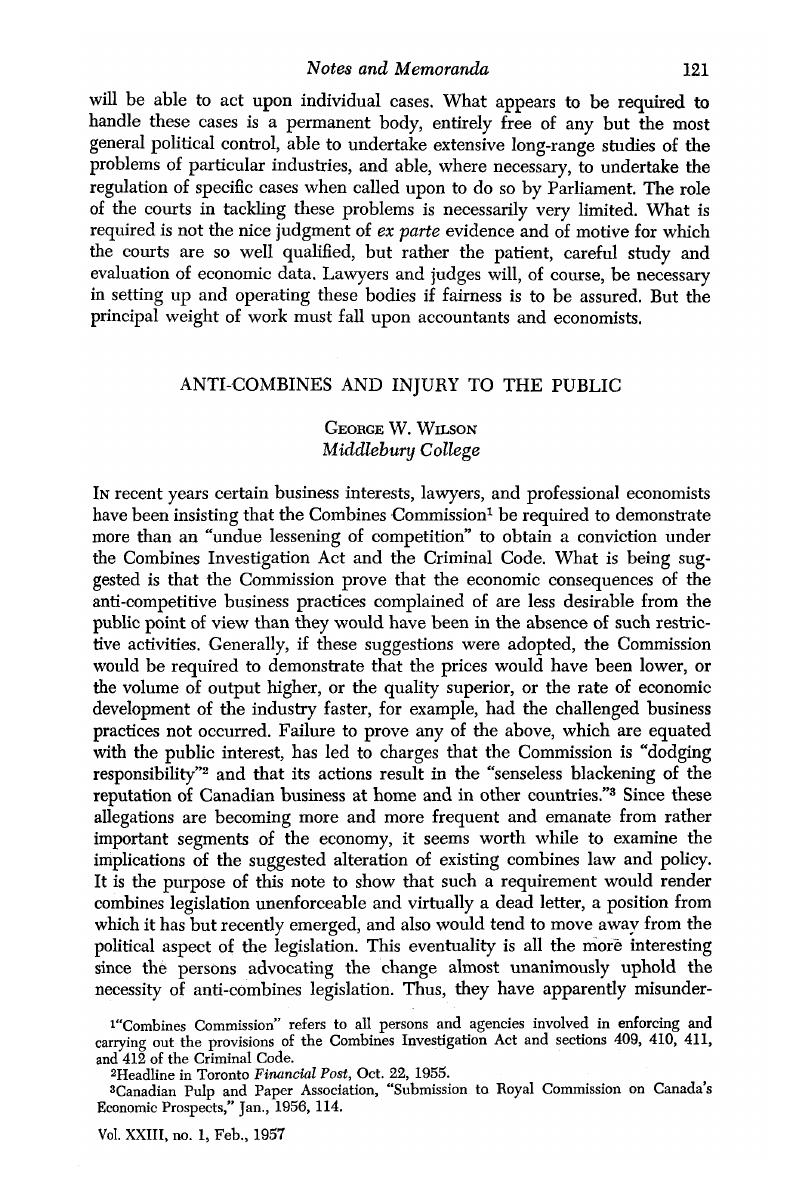No CrossRef data available.
Article contents
Anti-Combines and Injury to the Public
Published online by Cambridge University Press: 07 November 2014
Abstract

- Type
- Notes and Memoranda
- Information
- Canadian Journal of Economics and Political Science/Revue canadienne de economiques et science politique , Volume 23 , Issue 1 , February 1957 , pp. 121 - 127
- Copyright
- Copyright © Canadian Political Science Association 1957
References
1 “Combines Commission” refers to all persons and agencies involved in enforcing and carrying out the provisions of the Combines Investigation Act and sections 409, 410, 411, and 412 of the Criminal Code.
2 Headline in Toronto Financial Post, Oct. 22, 1955.
3 Canadian Pulp and Paper Association, “Submission to Royal Commission on Canada's Economic Prospects,” 01, 1956, 114.Google Scholar
4 Quoted in Saskatoon Star Phoenix, Nov. 27, 1953.
5 Quoted in Toronto Financial Post, Oct. 22, 1955.
6 “Submission to Royal Commission,” 111.
7 Quoted in Toronto Globe and Mail, Dec. 15, 1954.
8 Professor Bladen is quite explicit in urging the adoption of workable competition. See his submission to the Royal Commission on Canada's Economic Prospects entitled, “Competition and Monopoly and Their Regulation in Canada,” 3–5.Google Scholar
9 “The New Competition,” Yale Law Review, autumn, 1953, 48.Google Scholar
10 See, for example, Stigler's, George J. discussion in “Report on Antitrust Policy,” American Economic Review, Papers ana Proceedings, 05, 1956, 504–7.Google Scholar
11 It may be suggested in opposition to Mr. Stewart's criterion of the size of “relative profits on effective investment,’ that it would be virtually impossible to show when such profits were excessive. That is, a low rate of profit may be due to monopolistic inefficiency whereas a high rate of profit may be desirable, if there is freedom of entry, as a necessary inducement to new capital. Hence the size of profits on effective investment (and what is “effective investment”?) per se is of no value in determining public detriment. The size of profits must be examined in the light of the practices ana structure, both of which Mr. Stewart would ignore.
12 I need hardly remark that the terms “short” and ‘long” run are themselves highly nebulous.
13 Mason, E. S., “Market Power and Business Conduct,” American Economic Review, Papers and Proceedings, 05, 1956, 475.Google Scholar See also Solo, Robert, “The U.S. Attorney General's Report on the Antitrust Law,” Canadian Bar Review, 06–July, 1956, 681.Google Scholar
14 Skeoch, L. A., “The Combines Investigation Act: Its Intent and Application,” this Journal, XXII, no. 1, 02, 1956, 25.Google Scholar
15 See Bladen, , “Competition and Monopoly and Their Regulation in Canada,” 2 Google Scholar, where innovations competition is strongly emphasized. A good critique of the universal benefit of competition on the basis of innovations is given by Professors Britnell, Fowke, Timlin, and Buckley in their submission to the Royal Commission on Canada's Economic Prospects entided, “Workable Competition and Monopoly,” 5. They point out that the kind of innovation must be carefully examined before it can be held unequivocally that the public interest has been advanced. That is, innovations may represent technological advance or a form of product differentiation. The former is consistent with the public interest but there may be considerable doubt about the latter.
16 Stigler, George J., The Theory of Price (rev. ed., New York, 1952), 214.Google Scholar
17 Stykolt, S., “Combines Policy: An Economist's Evaluation,” this Journal, XXII, no. 1, 02, 1956, 40.Google Scholar
18 I should like to urge, however, that certain practices such as price fixing and market sharing be considered per se illegal for the well-known reasons presented in the justly famous Trenton Potteries decision in the United States. The Commission should take a somewhat broader approach to other practices, the dominant purpose of which is neither so obviously nor uniquely anti-competitive.
19 Stykolt, , “Combines Policy,” 40 ff.Google Scholar
20 Solo, , “The U.S. Attorney General's Report,” 683–4.Google Scholar


